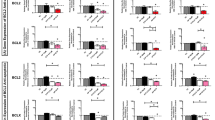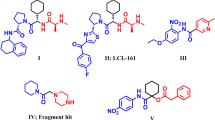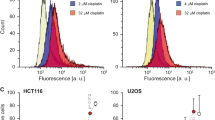Summary
We have previously reported that the putative cytoprotective protease inhibitor, plasminogen activator inhibitor type 2 (PAI-2), is specifically cleaved during okadaic acid-induced apoptosis in a myeloid leukaemic cell line (Br J Cancer (1994) 70: 834–840). HL-60 cells exposed to okadaic acid and camptothecin underwent morphological and biochemical changes typical of apoptosis, including internucleosomal DNA fragmentation and PAI-2 cleavage. Significant endogenous PAI-2 cleavage was observed 9 h after exposure to okadaic acid; thus correlating with other signs of macromolecular degradation, like internucleosomal DNA fragmentation. In camptothecin-treated cells, PAI-2 cleavage was an early event, detectable after 2 h of treatment, and preceding internucleosomal DNA fragmentation. The caspase I selective protease inhibitor, YVAD-cmk, inhibited internucleosomal DNA fragmentation and PAI-2 cleavage of okadaic acid and camptothecin-induced apoptotic cells. YVAD-cmk rather sensitively and non-toxically inhibited camptothecin-induced morphology, but not okadaic acid-induced morphology. In in vitro experiments recombinant PAI-2 was not found to be a substrate for caspase I. The results suggest that caspase I selective protease inhibition could antagonize parameters coupled to the execution phase of okadaic acid- and camptothecin-induced apoptosis, but not the commitment to cell death.
Similar content being viewed by others
Article PDF
Change history
16 November 2011
This paper was modified 12 months after initial publication to switch to Creative Commons licence terms, as noted at publication
References
Alnemri, E. S., Livingston, D. J., Nicholson, D. W., Salvesen, G., Thornberry, N. A., Wong, W. W. & Yuan, J. (1996). Human ICE/CED-3 protease nomenclature. Cell 87: 171
Bialojan, C. & Takai, A. (1988). Inhibitory effect of a marine sponge toxin, okadaic acid, on protein phosphatases. Biochem J 256: 283–290.
Bøe, R., Gjertsen, B. T., Vintermyr, O. K., Houge, G., Lanotte, M. & Døskeland, S. O. (1991). The protein phosphatase inhibitor okadaic acid induces morphological changes typical of apoptosis in mammalian cells. Exp Cell Res 195: 237–246.
Bøe, R., Gjertsen, B. T., Døskeland, S. O. & Vintermyr, O. K. (1995). 8-CI-cAMP triggers apoptosis in human mammary carcinoma cells (MCF-7) independently of the cAMP kinase. Br J Cancer 72: 1151–1159.
Cohen, G. M. (1997). Caspases: the executioners of apoptosis. Biochem J 326: 1–16.
Cohen, P., Holmes, C. F. B. & Tsukitani, Y. (1990). Okadaic acid: a new probe for the study of cellular regulation. TIBS 15: 98–102.
Clarke, P. G. (1990). Developmental cell death: morphological diversity and multiple mechanisms. Anat Embryol 181: 195–213.
Del Bino, G., Bruno, S., Yi, P. N. & Darzynkiewicz, Z. (1992). Apoptotic cell death triggered by camptothecin or teniposide. The cell cycle specificity and effects of ionizing radiation. Cell Prolif 25: 537–548.
Dickinson, J. L., Bates, E. J., Ferrante, A. & Antalis, T. M. (1995). Plasminogen activator inhibitor type 2 inhibits tumour necrosis factor alpha-induced apoptosis. Evidence for an alternate biological function. J Biol Chem 270: 27894–27904.
Dickinson, J. L., Norris, B. J., Jensen, P. H. & Antalis, T. M. (1998). The CD-interhelical domain of the serpin plasminogen activator inhibitor-type 2 is required for protection from TNFalfa induced apoptosis. Cell Death Diff 5: 163–171.
Gjertsen, B. T. & Døskeland, S. O. (1995). Protein phosphorylation in apoptosis. Biochim Biophys Acta 1269: 187–199.
Gjertsen, B. T., Cressey, L. I., Ruchaud, S., Houge, G., Lanotte, M. & Døskeland, S. O. (1994). Multiple apoptotic death types triggered through activation of separate pathways by cAMP and inhibitors of protein phosphatases in one (IPC leukemia) cell line. J Cell Sci 107: 3363–3377.
Golstein, P. (1997). Controlling cell death. Science 275: 1081–1082.
Greenlund, L. J. S., Korsmeyer, S. J. & Johnson, E. M. Jr (1995). Role of bcl-2 in the survival and function of developing and mature sympathetic neurons. Neuron 15: 649–661.
Jacobson, M. I., Burne, J. F. & Raff, M. C. (1994). Programmed cell death and bcl-2 protection in the absence of a nucleus. EMBO J 13: 1899–1910.
Jensen, P. H. (1997). Structure and function of plasminogen activator inhibitor-2: an intracellular serine proteinase inhibitor modulating apoptosis. Int J Oncol 11: 557–570.
Jensen, P. H., Christensen, E. I., Ebbesen, P., Gliemann, J. & Andreasen, P. A. (1990). Lysosomal degradation of receptor-bound urokinase-type plasminogen activator is enhanced by its inhibitors in human trophoblastic choriocarcinoma cells. Cell Reg 1: 1043–1056.
Jensen, P. H., Cressey, L. I., Gjertsen, B. T., Madsen, P., Mellgren, G., Hokland, P., Gliemann, J., Døskeland, S. O., Lanotte, M. & Vintermyr, O. K. (1994). Cleaved intracellular plasminogen activator inhibitor-2 in human myeloleukemia cells is a marker of apoptosis. Br J Cancer 70: 834–840.
Jensen, P. H., Jensen, T. G., Laug, W. E., Hager, H., Gliemann, J. & Pepinsky, B. (1996). The exon 3 encoded sequence of the intracellular serine proteinase inhibitor plasminogen activator inhibitor 2 is a protein binding domain. J Biol Chem 271: 26892–26899.
Kerr, J. F. R., Wyllie, A. H. & Currie, A. R. (1972). Apoptosis: a basic biological phenomenon with wide-ranging implications in tissue kinetics. Br J Cancer 26: 239–257.
Kiguchi, K., Glesne, D., Chubb, C. H., Fujiki, H. & Hubermann, E. (1994). Differential induction of apoptosis in human breast tumour cells by okadaic acid and related inhibitors of protein phosphatases 1 and 2A. Cell Growth Diff 5: 995–1004.
Kuida, K., Lippke, J. A., Ku, G., Harding, M. W., Livingston, D. J., Su, M. S. S. & Flavell, R. A. (1995). Altered cytokine export and apoptosis in mice deficient in interleukin-1β converting enzyme. Nature 267: 1998–2002.
Kumar, S. & Baglioni, C. (1991). Protection from tumour necrosis factor-mediated cytolysis by overexpression of plasminogen activator inhibitor type-2. J Biol Chem 266: 20960–20964.
McCarthy, N. J., Whyte, M. K. B., Gilbert, C. S. & Evan, G. I. (1997). Inhibition of Ced-3/ICE-related proteases does not prevent cell death induced by oncogenes, DNA damage, or the bcl-2 homologue bak. J Cell Biol 136: 215–227.
Mellgren, G., Bruland, T., Døskeland, A. P., Flatmark, T., Vintermyr, O. K. & Døskeland, S. O. (1997). Synergistic antiproliferative actions of cyclic adenosine 3′,5′-monophosphate, interleukin-1β, and activators of Ca++/calmodulin-dependent protein kinase in primary hepatocytes. Endocrinology 138: 4373–4383.
Nicholson, D. W. & Thornberry, N. A. (1997). Caspases: killer proteases. TIBS 22: 299–306.
Quan, L. T., Caputo, A., Bleackley, R. C., Pickup, D. J. & Salvesen, G. S. (1995). Granzyme B is inhibited by the cowpox virus serpin cytokine response modifier. J Biol Chem 270: 10377–10379.
Ray, C. A., Black, R. A., Kronheim, S. R., Greenstreet, T. A., Sleath, P. R., Salvesen, G. S. & Pickup, D. J. (1992). Viral inhibition of inflammation: cowpox virus encodes an inhibitor of the interleukin-1-beta converting enzyme. Cell 69: 597–604.
Rothenberg, M. L. (1997). Topoisomerase I inhibitors: review and update. Ann Oncol 8: 837–855.
Schumann, R. R., Belka, C., Reuter, D., Lamping, N., Kirschning, C. J., Weber, J. R. & Pfeil, D. (1998). Lipopolysaccharide activates caspase-1 (interleukin-1-converting enzyme) in cultured monocytic and endothelial cells. Blood 15: 577–584.
Shimizu, T. & Pommier, Y. (1997). Camptothecin-induced apoptosis in p53-null human leukemia HL-60 cells and their isolated nuclei: effects of the protease inhibitors Z-VAD-fmk and dichloroisocoumarin suggest an involvement of both caspases and serine proteases. Leukemia 11: 1238–1244.
Toivola, D. M., Goldman, R. D., Garrod, D. R. & Eriksson, J. E. (1997). Protein phosphatases maintain the organization and structural interactions of hepatic keratin intermediate filaments. J Cell Sci 110: 23–33.
Wyllie, A. H., Kerr, J. F. & Currie, A. R. (1980). Cell death: The significance of apoptosis. Int Rev Cytol 68: 251–305.
Zhivotovski, B., Gahm, A., Ankarcrona, M., Nicotera, P. & Orrenius, S. (1995). Multiple proteases are involved in thymocyte apoptosis. Exp Cell Res 221: 404–412.
Author information
Authors and Affiliations
Rights and permissions
From twelve months after its original publication, this work is licensed under the Creative Commons Attribution-NonCommercial-Share Alike 3.0 Unported License. To view a copy of this license, visit http://creativecommons.org/licenses/by-nc-sa/3.0/
About this article
Cite this article
Jensen, P., Fladmark, K., Gjertsen, B. et al. Caspase I-related protease inhibition retards the execution of okadaic acid- and camptothecin-induced apoptosis and PAI-2 cleavage, but not commitment to cell death in HL-60 cells. Br J Cancer 79, 1685–1691 (1999). https://doi.org/10.1038/sj.bjc.6690269
Received:
Revised:
Accepted:
Published:
Issue date:
DOI: https://doi.org/10.1038/sj.bjc.6690269
Keywords
This article is cited by
-
Khat (Catha edulis)-induced apoptosis is inhibited by antagonists of caspase-1 and -8 in human leukaemia cells
British Journal of Cancer (2004)
-
Many cuts to ruin: a comprehensive update of caspase substrates
Cell Death & Differentiation (2003)



